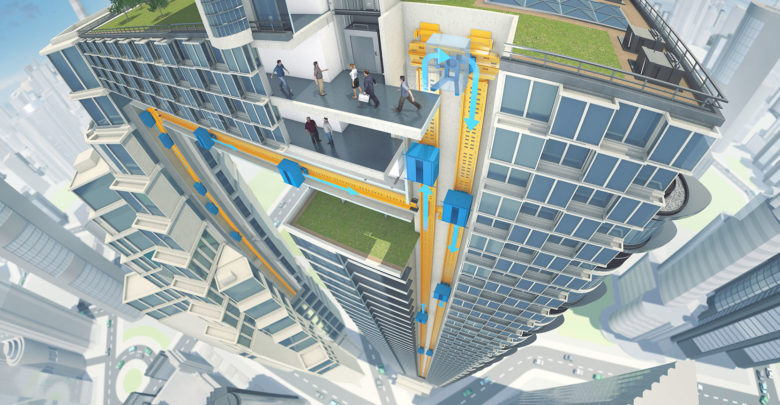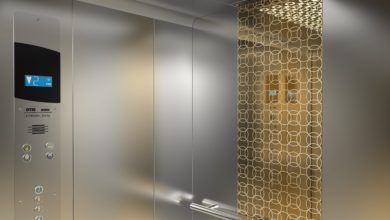“MULTI is set to revolutionize tall building construction”
thyssenkrupp has set a benchmark to the other association with its revolution in the elevator industry. C & A speaks to Bharat Vishnani, Managing Director, thyssenkrupp Elevator (India) Pvt. Ltd. about latest rope-less technology, developments, challenges, objectives and many more. Excerpts:

Q) MULTI, the world’s first rope-less horizontal-vertical elevator system. Tell us more about this technology. Is it going to transform the entire elevator sector? Market reaction?
thyssenkrupp has introduced the elevator industry’s holy grail and the end of the 160-year reign of the rope-dependent elevator. MULTI as it’s popularly known as, harnesses the power of linear motor technology to move multiple cars in a single shaft both vertically and horizontally!
MULTI is set to revolutionize tall building construction. With MULTI’s rope-free system, architects and developers are no longer restricted in their designs by concerns about elevator shaft height and vertical alignment. MULTI opens the door to design possibilities in all directions.
MULTI consolidates multiple carriages into fewer shafts. It reduces the elevators’ footprint by up to 50% while increasing passenger throughput by at least as much. MULTI may also help reduce the building’s overall size, external surface area and total energy consumption.
We’ve integrated advances in lightweight design, including new lightweight carbon composites, to reduce MULTI’s cabin and door weight by up to 50%. Eliminating the ropes and counterweights of conventional elevators also decreases the mass of the elevator system.
Q) Talking of standard product configuration or a tailor made design, please share the details of line of merchandise and exertions to make them efficient and reliable in marketplace?
We have a wide range of products to meet the requirements of our customers be it standard product configuration for low and mid-rise, affordable housing projects or tailor made designs for high-end, high rise projects.
“With the launch of MPF, we are now in a much stronger position to serve the second largest elevator market in the World”
Q) Being a global leader and having worldwide experience, how competitive and challenging is Indian market?
Every market has its own challenges. The major impediment in the Indian elevator market is that despite being the second largest, it isn’t the most high-tech in the world. The number of high rise towers being built is still relatively small, which means the elevators supplied have generally lower speeds and less sophisticated control systems. The recent slowdown in the real estate market has resulted in delays in order finalisation and project completion, which has impacted the growth of elevator industry too.
Q) Few months back thyssenkrupp has inaugurated its newest Multi-Purpose Facility (MPF) world class elevator manufacturing site in Pune. Given that, what are the objectives and developments organization looking for through this project?
This plant, rightly called Multi-Purpose Facility (MPF), is built on 84,000 square metres of land with an investment of about Rs.300 Crs. It includes manufacturing & logistics centre, customer showroom cum experience centre, training centre and R&D centre.
With this facility we are now in a much stronger position to serve the second largest elevator market in the world. And the future looks promising with hopes of good market growth fueled by positive developments on the Government policy front. Noteworthy of these are the Infrastructure status awarded to affordable housing, drive on Urbanization, Smart city concept and GST rollout. All these factors will directly or indirectly give a strong impetus to our industry”.
The initial annual production capacity is planned for 6,000 units, which will get extended to 10,000 units in next few years. Elevators produced here are based on German technology and engineering design, adapted for local standards and market needs across various segments.
“At the Energy Efficiency Global Forum in Washington DC thyssenkrupp recently showcased its latest innovation in making urban mobility greener: a net-zero energy system which can be used for existing elevators”
Q) “Energy creating “elevators are already popular where the elevator’s kinetic energy gets converted into electricity. Moving one step further, the company has come up with an idea of net-zero unit. Please share the details with us.
At the Energy Efficiency Global Forum in Washington DC thyssenkrupp recently showcased its latest innovation in making urban mobility greener: a net-zero energy system which can be used for existing elevators. With buildings now accounting for as much as 40% of global energy consumption, this breakthrough marks a milestone moment for the building industry and opens the door to more energy-savvy technologies being implemented to tackle resource scarcity.
“Energy creating” elevators are already popular, converting the elevator’s kinetic energy into electricity that can be fed back into the building’s power grid. thyssenkrupp installed this solution at the One World Trade Center in New York, where the elevators regenerate energy in an amount that could feed the building’s entire lighting system.
But the new net-zero concept goes one step further, focusing on improving energy efficiency even when the elevator is idle, which can be as much as 70% of its working life. The design uses new controllers which trigger “hibernation” or “sleep” modes in idle cabins thus significantly reducing the energy demand. The required energy can be generated using solar panels no larger than the footprint of the elevator shaft, creating net-energy positive systems that generate more energy than they consume.



